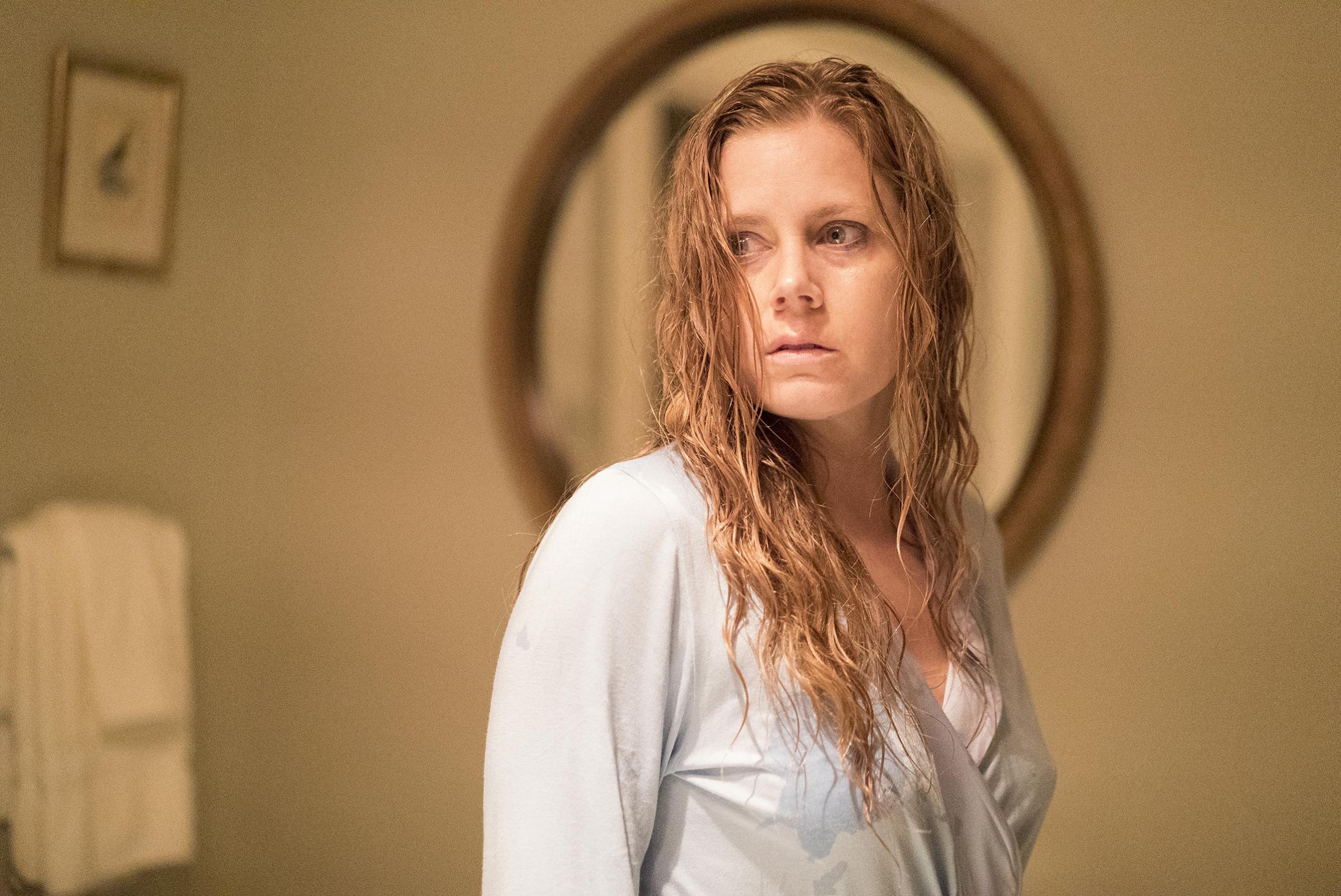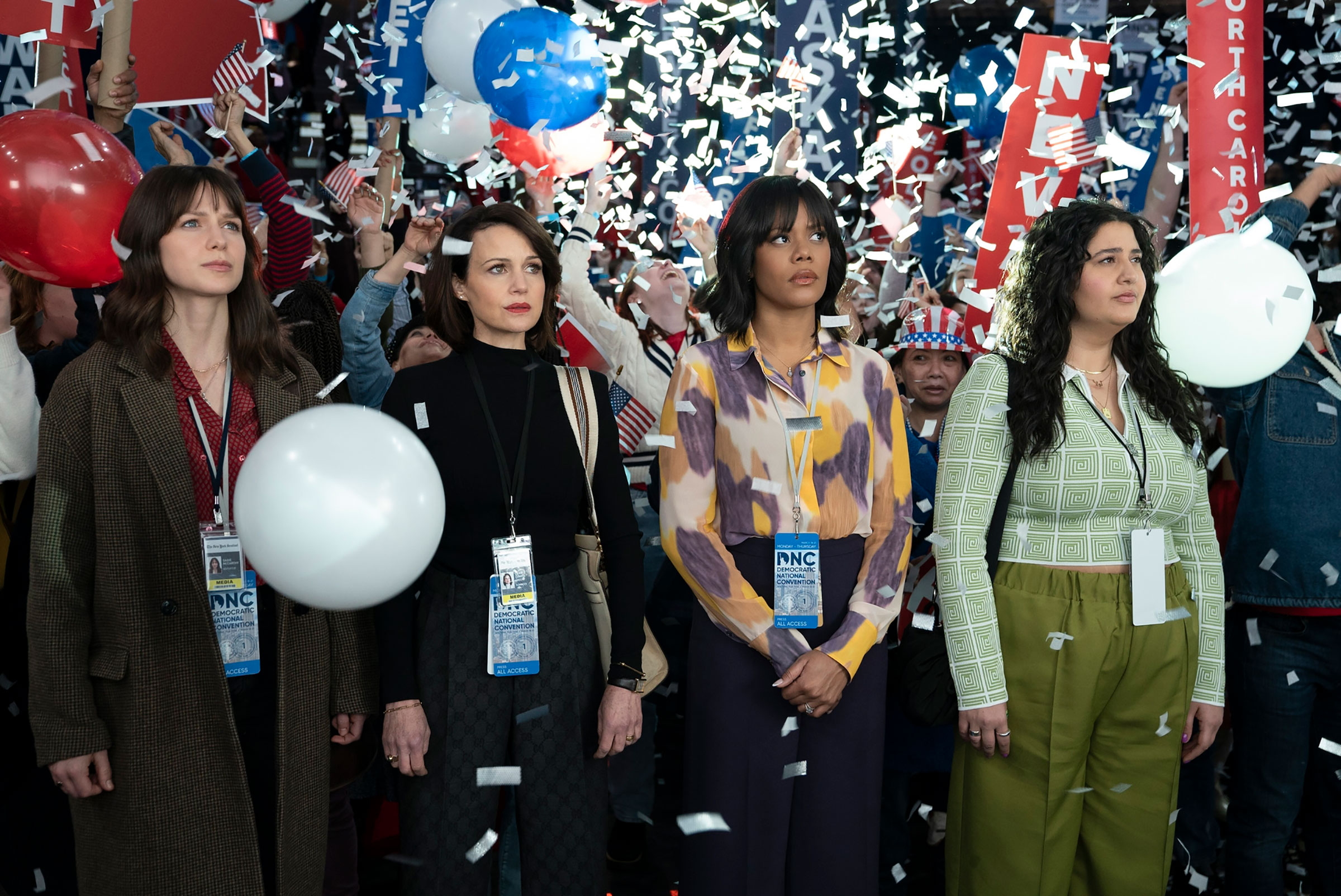Sadie McCarthy, the newspaper-reporter heroine of Max’s The Girls on the Bus, has seen the way women like her are depicted on screen, and she is not impressed. “I hate when Hollywood portrays female journalists using sex to get the facts,” she gripes midway through the dramedy’s first season, “while male journalists always use their brilliant minds and unimpeachable morality to get the story.” She’s absolutely right. Which is why it's so strange that, by the time she makes the comment, the series has already incorporated a version of the latter noxious cliché, among many others.
Inspired by co-creator and New York Times veteran Amy Chozick’s campaign-trail memoir Chasing Hillary, The Girls on the Bus, premiering March 14, sets out to refute tropes that date back to the His Girl Friday era. Its ultimate failure to do so—or to create any female characters who feel like distinctive people, rather than stereotypes meant to represent various ages and ethics of women in media—makes the show a disappointment. More than that, though, amid our eternal surfeit of campy shows about lady reporters, from The Bold Type to The Morning Show, it raises the question of why it’s so hard to make good TV that takes female journalists seriously.

Following the press corps that follows a fictional field of Democrats through a twisty presidential primary season, Bus takes a Breakfast Club approach to cast building. Carla Gugino’s Grace is the veteran, a cutthroat scoop factory who neglects her long-suffering husband and college-student daughter. The only Black correspondent at a right-wing news network (imagine Candace Owens but likable), Kimberlyn (Christina Elmore) is too busy angling for advancement to plan her wedding. Gen Z caricature Lola (Natasha Behnam), a sexually fluid school-shooting survivor turned influencer, openly supports a progressive candidate clearly modeled on AOC, dresses like she’s trying to wear every stitch of Haley Lu Richardson’s White Lotus wardrobe at once, and knows precisely zilch about journalism. From vain lightweight to ambitious woman = bad mom, these three have all the major stereotypes about women in the workplace covered.
Which leaves Sadie (Supergirl’s charming Melissa Benoist) to be the relatable one, a reporter for a fictional paper of record whose paternalistic editor (Griffin Dunne) is giving her one last shot at a high-profile assignment, after an extremely un-objective public meltdown when her candidate of choice lost the previous election made her the laughingstock of the industry. Emotional, prone to self-humiliation, and perennially flustered in the most endearing way, she is essentially a rom-com lead in the Dakota Johnson mold. She isn’t technically doing anything wrong when she hooks up with a political-operative ex (Brandon Scott) while he’s between campaign jobs, but you would think she’d be savvy enough not to jump into bed with someone who will likely soon have a different boss she’ll be reporting on. Alas, Sadie isn’t even the only member of the central foursome who gets it on with an employee of a candidate she’s covering.

What’s remarkable about the trope of women journalists sleeping with sources is how tenacious it has proven to be, despite decades of pushback from the overwhelming majority of real female journalists who have never so much as thought about crossing that line. Sharp Objects, Trainwreck, Top Five, Thank You for Smoking, and even a jaded Rory Gilmore in Netflix’s 2016 Gilmore Girls revival are just a few prominent 21st century examples. Kate Mara played a particularly nasty (and ill-fated) variation on the archetype in House of Cards, which had her character Zoe Barnes exchanging sex for intel with Kevin Spacey’s sociopathic congressman, Frank Underwood. While based-on-a-true-story films like She Said, Spotlight, and Whiskey Tango Foxtrot typically show women journalists more respect than pure fiction, even the 2019 biopic Richard Jewell worked in a fact-free portrayal of a real, deceased female reporter sleeping with sources. Don’t worry; the backlash to that depiction didn’t change anything. This past fall, The Morning Show gave us a storyline in which veteran anchor Alex Levy (Jennifer Aniston) dates a billionaire subject who is in talks to buy the company that employs her. (In Alex’s defense, the character was played by Jon Hamm.)
Asked about the line-crossing relationship in an interview, showrunner Charlotte Stoudt explained that she “wanted to see a different side of Alex. I felt it was important that they actually did consummate that attraction because Alex has had a really bad run!” It’s a telling response, in that it illuminates why even feminist-minded female writers, like Bus’ Chozick and co-creator Julie Plec or Sharp Objects’ Marti Noxon and Gillian Flynn, might repeat a famously toxic trope. Stoudt’s comment reminds me of Sophie Gilbert’s observation in The Atlantic, during Objects’ 2018 run, that the phoning and typing most good reporters spend most days doing doesn’t lend itself to gripping entertainment. So the people who make movies and TV have to add some elements that might not accurately reflect reality. “Fantastical stories about female journalists might be preposterous,” Gilbert writes, “but they were also entertaining.”

When those stories are aimed at a female audience, as shows that center around women generally are, they tend to get forced into genres—i.e., romantic comedy and emotional drama—that creators or producers or Hollywood executives think will appeal to that audience. In these contexts, the sleeping-with-sources trope becomes a symptom of the larger problem with explicitly gendered entertainment. It uses time-worn formulas and sexist assumptions that pander to a demographic seen as monolithic instead of honoring the specificity of characters’ experiences. By contrast, shows and films that foreground male journalists—The Newsroom, All the President's Men, Network, The Hour, the final season of The Wire—tend to be straightforward dramas, unbeholden to assumptions about a gendered audience. That’s not to say that lighthearted shows whose protagonists happen to be women journalists shouldn’t exist. It’s pointless to seethe over the fanciful plots of The Bold Type or Ugly Betty or Being Mary Jane. No one believes Carrie Bradshaw, typing glib questions into Word docs, surrounded by $800 shoes in a million-dollar apartment, leads the life of a typical columnist.
The trouble is, even shows that purport to take journalism seriously have a habit of turning sappy or campy when the main characters are female. The Morning Show is the ultimate case in point. Conceived as a prestige drama fit to be the flagship original series on Apple TV+, it cast A-list executive producers Aniston and Reese Witherspoon as co-anchors trying to remake a thinly veiled facsimile of the Today show after a sexual misconduct scandal à la Matt Lauer. But it was built on the skeleton of a soap, with Alex in the role of aging diva and Witherspoon’s firebrand Bradley Jackson as a younger upstart. Workplace romances run rampant, including Bradley’s ongoing will-they-or-won’t-they with network exec Cory Ellison (Billy Crudup), while plots feel ripped from the tabloids. By the time the third season aired, last year, the Guardian spoke for fans and detractors alike in pronouncing it “the most ridiculous show on TV.”

Although (with the exception of Sadie’s periodic conversations with the apparition of her unlikely idol, Hunter S. Thompson) it’s a bit more grounded, The Girls on the Bus falls into similar traps. This seems to have happened not just in spite of its makers’ intent to address widespread misrepresentation, but at least partially because of it. In an interview that questions the motives behind Sadie’s romantic indiscretion, Benoist explains: “We show that the trope is something that should be commented on and not told anymore because it’s just not possible. Your career would be over if you did that; you’d be a pariah. What we’ve seen, it’s like, ‘That’s just how female journalists get their information.’ It’s not.” So—paradoxically, in my mind—“the way we’re approaching this is that it is a massive mistake that Sadie makes.” A better way to subvert a trope you believe should be “not told anymore” might have been to simply not retell it.
The same goes for the other characters, who we slowly learn are, sort of, sometimes, more than the caricatures we meet in the premiere. Beneath all the sponcon and sanctimony, Lola has the heart of a journalist. Kimberlyn has more integrity, and more to say, than the Tucker Carlsons and Tomi Lahrens who keep stealing her spotlight. Grace isn’t a bad mom or wife at all—except, based on the evidence of early episodes, she inarguably is. As a unit, lusting after Scott Foley’s “hot white guy” candidate and throwing hotel-room pajama parties, the foursome embodies Bus’ true subject, which turns out not to be journalism or the political process but female friendship of the most generic variety. “We may have started as competitors, but we ended as a family,” says Sadie, in the show’s unnecessary (and inevitably Bradshaw-coded) voiceover narration.

The Girls on the Bus’ gendered silliness is hardly its only problem, nor is a series about four very different women journalists who happen to be best friends an inherently bad idea. It’s just a shame that this kind of character, marginalized and belittled as they commonly are in macho media dramas, so rarely gets to be anything besides a stock type or, in this case, an equally flat rejoinder to same. It’s hard to predict whether more serious and authentic television about female journalists would find a receptive audience because the few attempts that have appeared in recent years—most notably, Amazon’s Good Girls Revolt and ABC’s Alaska Daily, both canceled after just one season—have been so shoddily made. Like every good journalist understands, an earnest investigation is the only way to know for sure.
More Must-Reads From TIME
- The 100 Most Influential People of 2024
- Coco Gauff Is Playing for Herself Now
- Scenes From Pro-Palestinian Encampments Across U.S. Universities
- 6 Compliments That Land Every Time
- If You're Dating Right Now , You're Brave: Column
- The AI That Could Heal a Divided Internet
- Fallout Is a Brilliant Model for the Future of Video Game Adaptations
- Want Weekly Recs on What to Watch, Read, and More? Sign Up for Worth Your Time
Contact us at letters@time.com
